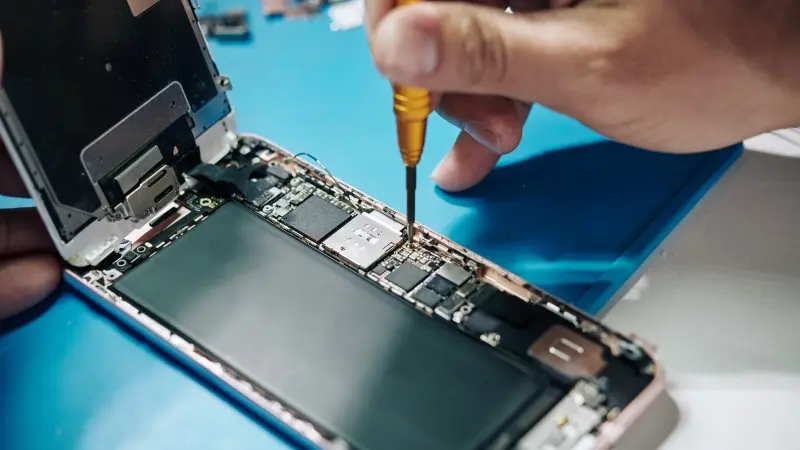Explore the unique attributes and cutting-edge performance of Apple’s A-series chips in iPhones, highlighting what makes them stand out in the mobile industry.
Apple’s A-series chips, which power the iPhone, are a cornerstone of the device’s appeal and market success.
These chips are renowned for their exceptional performance, energy efficiency, and integration with iOS, Apple’s operating system.
Also Read
This article delves into what makes the A-series chips special, from their custom architecture to their impact on gaming and professional applications, and how they compare with competitors.
1. Custom Silicon Design
One of the key elements that set Apple’s A-series chips apart is their custom silicon design.
Unlike many competitors who rely on standard chip designs from companies like Qualcomm or MediaTek, Apple designs its processors in-house.
This allows Apple to tailor the architecture specifically to its operating system and software, ensuring that both hardware and software are tightly integrated.
This integration enhances the overall efficiency and performance of iPhones, providing a seamless user experience that is hard to replicate with off-the-shelf components.
2. High Performance and Energy Efficiency
Apple’s A-series chips are designed to deliver high performance without compromising battery life.
This is achieved through a balance of high-performance cores for demanding tasks and energy-efficient cores for everyday activities.
For instance, the A13 Bionic chip features two high-performance cores and four efficiency cores.
This configuration allows the iPhone to handle intensive tasks like video editing and 3D gaming effortlessly, while also being energy efficient for tasks like emailing and web browsing.
3. Advanced Neural Engine
Starting with the A11 Bionic chip, Apple introduced a dedicated component called the Neural Engine.
This part of the chip is designed to handle machine learning and artificial intelligence tasks, which are increasingly important in mobile technology.
The Neural Engine enables features such as face recognition, augmented reality, and real-time language translation, enhancing the capabilities of iPhone apps and functionalities.
Each new iteration of the A-series chip has seen improvements in the Neural Engine, which now can perform billions of operations per second, vastly speeding up AI processes.
4. Graphics Processing Capabilities
Apple’s A-series chips are not only about CPU performance but also excel in graphics processing.
This is particularly beneficial for gaming and professional creative applications, which require robust graphics capabilities.
Apple designs its own GPU (Graphics Processing Unit) that is integrated into the A-series chips, optimizing graphics performance for smoother animations and more realistic visual effects, making the iPhone a strong competitor in mobile gaming and professional graphic applications.
5. Impact on Photography and Videography
The A-series chips significantly enhance the iPhone’s photography and videography capabilities.
Through advanced image processing algorithms powered by the chip, iPhones can perform tasks like computational photography which includes features like Night mode, Deep Fusion, and Smart HDR.
These technologies allow users to capture high-quality photos in various lighting conditions. Moreover, the powerful chip enables 4K video recording and editing directly on the iPhone, appealing to both amateur and professional videographers.
6. Security Features
Security is a paramount feature in mobile devices, and Apple’s A-series chips contribute significantly to this aspect through the Secure Enclave.
This coprocessor handles data encryption for Touch ID and Face ID, ensuring that users’ biometric data is stored securely on the device.
Additionally, it oversees secure boot and encrypted storage functionalities, making iPhones some of the most secure consumer devices available.
7. Future-Proofing
Apple’s forward-thinking design philosophy means that A-series chips are built to support software updates and new features for several years after a device’s release.
This future-proofing is a significant advantage for consumers, as it ensures that even older iPhone models remain relevant and performant with the latest iOS versions and applications.
8. Enhanced Connectivity
With each new iteration, A-series chips have integrated advanced wireless technologies to improve connectivity.
Features like faster Wi-Fi speeds, improved cellular reception, and the introduction of 5G are all supported by the latest chips.
This not only enhances the user experience but also ensures that iPhones can take full advantage of the latest advancements in wireless technology.
9. Customizability and Control
By designing its own chips, Apple retains full control over the integration of hardware and software.
This level of control is rare in the industry and allows Apple to optimize performance to a degree that other manufacturers often cannot match.
It also enables Apple to provide a consistent experience across all its devices, reinforcing the ecosystem’s strength.
10. Industry Influence
The innovation and success of Apple’s A-series chips have not only benefited iPhone users but also influenced the broader mobile industry.
Competitors are increasingly investing in their own custom silicon solutions to keep up with the benchmarks set by Apple.
This trend towards custom chip solutions is shaping the future of mobile device capabilities, pushing the boundaries of what smartphones can achieve.
Apple’s A-series chips are a defining feature of the iPhone, driving its capabilities far beyond that of just a communication device.
From enhancing the user experience through integrated software and hardware design to pushing the envelope in AI, graphics, and security, the A-series chips have set a high standard in the mobile industry.
As technology evolves, it is clear that these chips will continue to play a crucial role in defining the future of Apple’s devices, confirming the iPhone’s position at the forefront of innovation.














